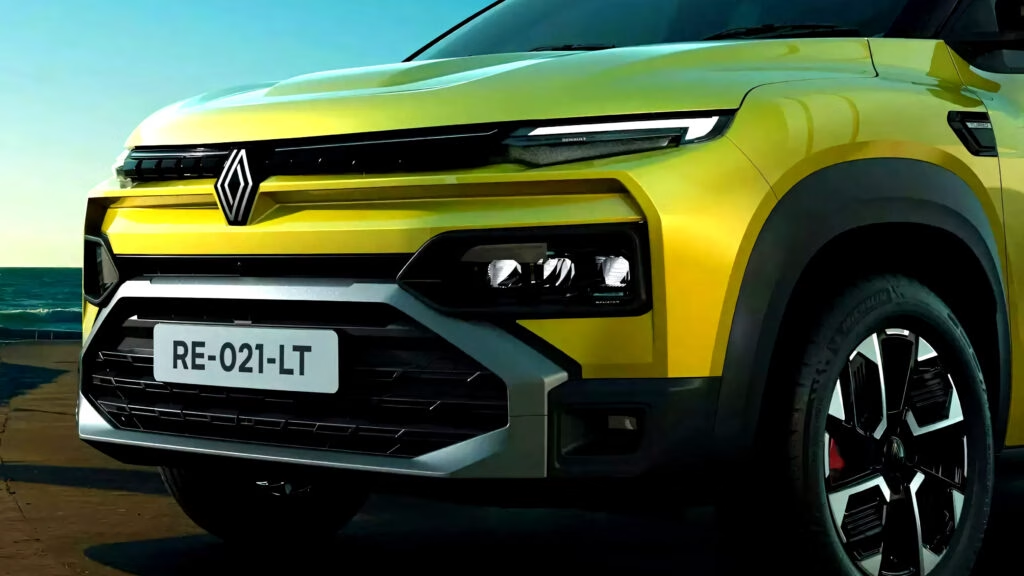How does the Renault Kiger’s facelift help it stand out in India’s crowded sub-4m SUV market?
Renault’s Kiger has always played the value card in India’s fiercely competitive sub-4-meter SUV space. But with rivals like the Tata Nexon, Kia Sonet, and Mahindra XUV 3XO constantly raising the bar, a simple price advantage isn’t enough anymore. That’s where the latest facelift comes in, aiming to keep the Kiger fresh without straying from its affordable roots.
The most obvious changes are up front. The new bumper, slimmer grille, and beefier skid plate give the Kiger a sharper, more assertive look. Renault hasn’t gone overboard—think subtle tweaks rather than a full makeover. The split headlamp design remains, now joined by extra fog lamps for better visibility in those unpredictable monsoon downpours. Around the sides, you’ll spot new graphics on the doors and C-pillar, plus a snazzy set of 16-inch alloys on the top trim. Out back, the bumper gets a redesign too, with faux inlets and a chunkier skid plate.
Why do these details matter? In a segment where style often seals the deal, even small visual updates can sway buyers. The Kiger’s new face helps it stay in the conversation, especially among younger drivers who want something that stands out in the parking lot.
What’s new inside the Kiger’s cabin, and does it feel more premium now?
Step inside, and you’ll notice Renault’s focus on making the cabin a bit more inviting. There’s a new white dashboard trim, updated seat upholstery, and the latest Renault badge on the steering wheel. But the real win here is improved insulation—meaning less road noise, more peace and quiet on your commute.
The 8-inch infotainment touchscreen is still the centerpiece, but higher trims now offer some genuinely useful upgrades: a 360-degree camera for stress-free parking, an Arkamys-tuned audio system for better sound, wireless charging, and ventilated front seats in the top-spec Emotion grade. These aren’t just gimmicks—they’re features that make everyday driving more comfortable, especially in India’s sweltering summers.
That said, the entry-level Authentic trim is pretty barebones. No touchscreen, no steering wheel controls—just a basic storage slot where the display would be. Still, Renault has made six airbags, hill start assist, and rear parking sensors standard across the range. That’s a big deal for safety, especially as more Indian buyers prioritize crash protection.
Are there any changes under the hood, or is it the same Kiger as before?
Mechanically, the Kiger sticks to its proven formula. You get a choice between a naturally aspirated 1.0-liter three-cylinder engine (71 hp) and a punchier turbocharged version (99 hp). Both are paired with front-wheel drive. Transmission options include a five-speed manual, an AMT for the base engine, and a CVT for the turbo. No hybrid or diesel here—Renault is betting that simplicity and reliability still matter most to its core audience.
While some might wish for more power or electrification, the current setup keeps costs down and maintenance simple. For city dwellers and first-time buyers, that’s often more important than headline-grabbing horsepower figures.
How does the Kiger’s pricing stack up against its rivals?
Affordability remains the Kiger’s ace. The base Authentic trim with the manual gearbox starts at Rs 6.30 lakh (about $7,200), only a minor bump from the outgoing model. The fully loaded Emotion with the turbo engine and CVT tops out at Rs 11.30 lakh (roughly $12,900). That undercuts several competitors, especially when you factor in the standard safety kit.
For context, the Tata Nexon and Kia Sonet both start higher and can get pricier as you climb the trim ladder. The Kiger’s pricing strategy is clear: offer just enough features and flair to keep buyers interested, but don’t stray from the value proposition that made it popular in the first place.
Does the Kiger’s update address real-world needs, or is it just about looks?
Here’s where things get interesting. Renault hasn’t just slapped on new bumpers and called it a day. The addition of six airbags across all trims is a direct response to growing consumer demand for safer cars in India—a trend backed by recent surveys from the Indian Automobile Manufacturers Association. Better cabin insulation and the option for ventilated seats show Renault is listening to everyday complaints, not just chasing trends.
On the flip side, the lack of any electrified powertrain or major tech leap might disappoint some. But for most buyers in this segment, reliability, low running costs, and a hassle-free ownership experience still trump cutting-edge gadgets.
What’s the big takeaway for buyers considering the new Renault Kiger?
The Kiger’s facelift isn’t about reinventing the wheel. It’s about making smart, targeted improvements—sharper looks, better safety, a quieter cabin—while keeping the price within reach for young families and first-time SUV buyers. If you’re after a sub-4m SUV that balances style, practicality, and value, the refreshed Kiger deserves a look.
The big takeaway? Upgrading your daily drive isn’t about perfection—it’s about smarter adjustments. Start with one change this week, and you’ll likely spot the difference by month’s end.

